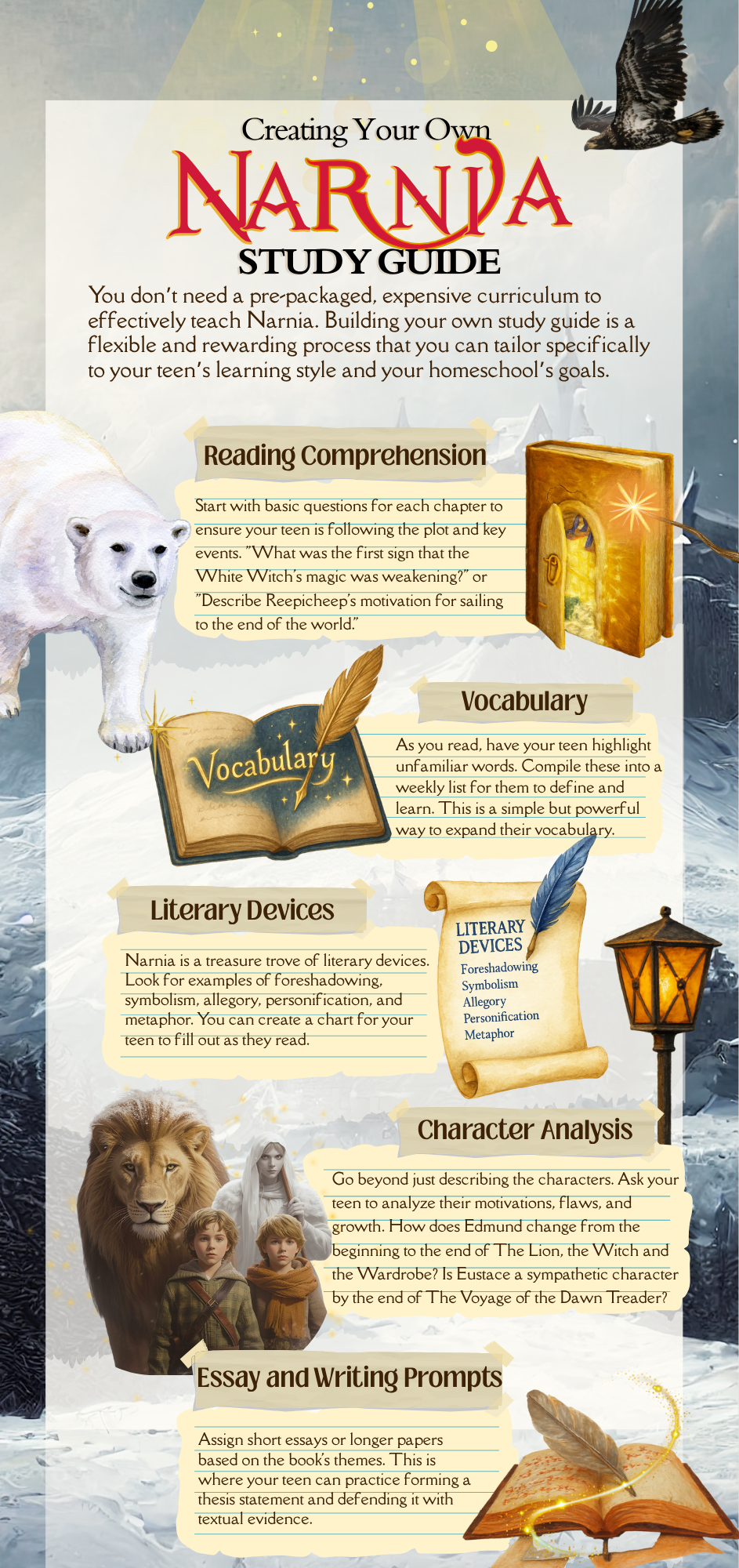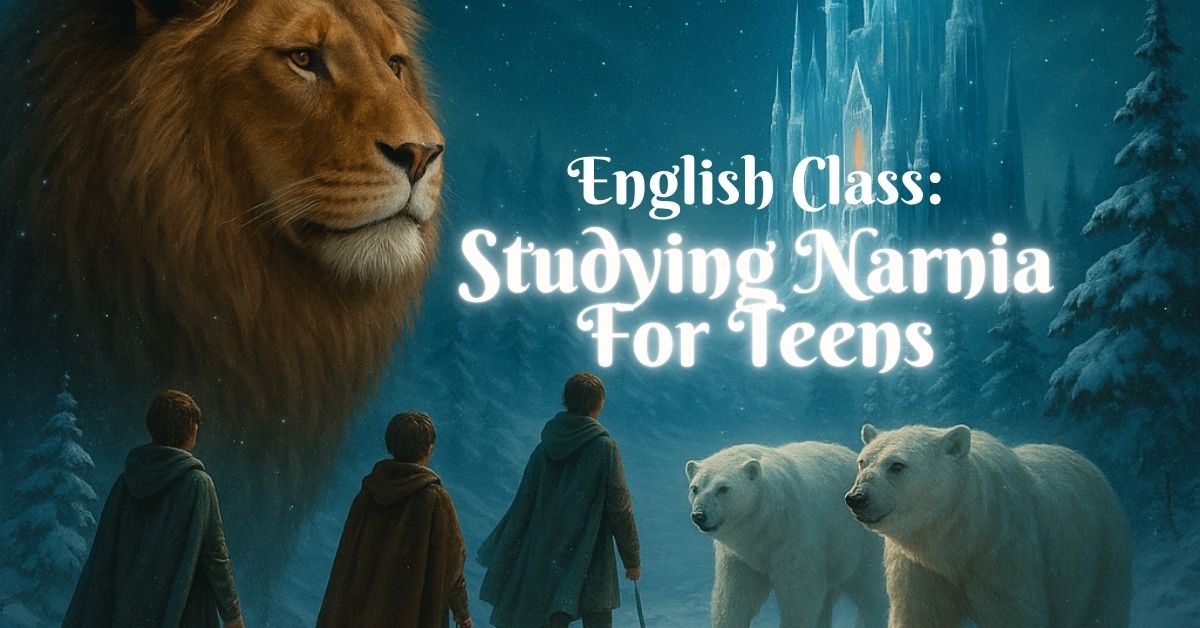Finding the right literature for your homeschool teen can feel like a quest of its own. You want something engaging, layered, and full of teachable moments. What if you could turn a beloved fantasy series into a comprehensive English credit? With the right approach, the world of Narnia can be more than just a magical escape; it can be the foundation of a robust high school literature course. Using a flexible Narnia study guide framework allows you to dive deep into C.S. Lewis’s timeless stories, covering everything from character analysis to complex literary themes with your teen.
The beauty of using The Chronicles of Narnia for high school is its incredible depth. These aren’t just simple children’s stories. They are rich with allegory, complex characters, and profound questions about faith, courage, and human nature. This makes them perfect for teens who are ready to move beyond basic plot summaries and engage in deeper critical thinking. You can craft an entire year’s curriculum around this series, creating a memorable and effective learning experience.
Why Narnia is Perfect for Homeschool Teens
Choosing Narnia for your high school literature curriculum offers a unique blend of academic rigor and genuine enjoyment. These stories have a magical way of capturing the imagination while providing substantial material for literary analysis. They are accessible enough for reluctant readers yet layered enough to challenge advanced students.
- Builds on Fondness: Many teens grew up with these stories, either through the books or the movies. Using a familiar world as the basis for study removes the intimidation factor that can come with classic literature. It feels less like a chore and more like revisiting old friends.
- Rich Thematic Content: The books are packed with powerful themes. You can explore concepts like betrayal and forgiveness in The Lion, the Witch and the Wardrobe, the dangers of temptation in The Voyage of the Dawn Treadera, and the nature of creation in The Magician’s Nephew. These are meaty topics that spark fantastic discussions.
- Adaptable for Different Levels: You can easily scale the assignments up or down. A younger teen might focus on identifying literary devices and tracking character development. An older or more advanced student could write in-depth essays on the theological allegories or compare Lewis’s philosophical viewpoints to other writers.
- Excellent for Vocabulary Building: Lewis was a master of the English language. His writing is beautiful and descriptive, filled with rich vocabulary that can be compiled into weekly lists. Studying his word choices is a lesson in itself.
Creating Your Own Narnia Study Guide
You don’t need a pre-packaged, expensive curriculum to effectively teach Narnia. Building your own study guide is a flexible and rewarding process that you can tailor specifically to your teen’s learning style and your homeschool’s goals. Start by deciding which books you want to cover. While many read them in publication order starting with The Lion, the Witch and the Wardrobe, reading them in chronological order, beginning with The Magician’s Nephew, offers a different and equally valid experience.
Once you have your reading order, break down the study for each book. A simple structure might involve reading a few chapters each week, followed by discussion and a related assignment. Consider incorporating a mix of activities to keep things interesting. You could have your teen write diary entries from the perspective of a character, create maps of Narnia, or even film their own “movie trailer” for one of the books. The goal is to encourage engagement with the text on multiple levels.

For a more formal credit, you’ll want to structure your guide with specific academic components. Think about what a traditional English class would cover and adapt it for Narnia.
- Reading Comprehension: Start with basic questions for each chapter to ensure your teen is following the plot and key events. “What was the first sign that the White Witch’s magic was weakening?” or “Describe Reepicheep’s motivation for sailing to the end of the world.”
- Vocabulary: As you read, have your teen highlight unfamiliar words. Compile these into a weekly list for them to define and learn. This is a simple but powerful way to expand their vocabulary.
- Literary Devices: Narnia is a treasure trove of literary devices. Look for examples of foreshadowing, symbolism, allegory, personification, and metaphor. You can create a chart for your teen to fill out as they read.
- Character Analysis: Go beyond just describing the characters. Ask your teen to analyze their motivations, flaws, and growth. How does Edmund change from the beginning to the end of The Lion, the Witch and the Wardrobe? Is Eustace a sympathetic character by the end of The Voyage of the Dawn Treader?
- Essay and Writing Prompts: Assign short essays or longer papers based on the book’s themes. This is where your teen can practice forming a thesis statement and defending it with textual evidence.
Incorporating the Movies
Let’s be honest: movie days are a fantastic part of homeschooling. The film adaptations of The Lion, the Witch and the Wardrobe (2005) and Prince Caspian (2008) are visually stunning and provide a great opportunity for comparative analysis. Watching the movies after reading the books opens up a whole new avenue for discussion and learning. It’s a fun way to reward your teen for finishing a book while still keeping their critical thinking gears turning.
When you watch, don’t just put your feet up with a bowl of popcorn (though you should definitely do that, too!). Treat it as an extension of the lesson. The key is to have your teen analyze the movie as an adaptation. Discuss the choices the director and screenwriters made. What parts of the book were changed, added, or left out? Why do you think they made those choices? Did the changes improve the story or weaken it?
This exercise teaches valuable media literacy skills. Your teen will learn that a movie based on a book is not just a visual representation but an interpretation. Here are some specific questions you can use to guide a book-vs-movie discussion:
- Did the actors portray the characters as you imagined them?
- How did the movie handle the book’s internal monologues or narrator’s insights?
- Was the tone of the movie consistent with the tone of the book?
- Which scenes were more powerful in the book, and which were more powerful on screen?
- Did the movie’s special effects help or hinder the storytelling?

Going Deeper: Teaching C.S. Lewis
Studying Narnia is also the perfect gateway to studying the brilliant mind behind it: C.S. Lewis. For older or more curious teens, learning about the author adds incredible context to the stories. Lewis was a fascinating figure—an Oxford don, a Christian apologist, a former atheist, and a member of the famous literary group, The Inklings, alongside J.R.R. Tolkien. Understanding his life and philosophical journey illuminates the deeper layers of meaning within Narnia.
You can assign a short biography of Lewis for your teen to read. Learning about his experiences in World War I, his deep friendships, and his conversion to Christianity provides a rich backdrop for the themes of war, sacrifice, and faith that are so prevalent in his work. This transforms the lesson from a simple literature study into an interdisciplinary exploration of history, philosophy, and theology, giving your teen a more holistic educational experience.
Sample Essay Prompts for a High School Level
To truly challenge your teen and help them hone their writing skills, you need essay prompts that require them to think critically and argue a point. Move beyond simple book reports with questions that demand analysis and evidence from the text.
- Analyze the character arc of Edmund Pevensie in The Lion, the Witch and the Wardrobe. How does C.S. Lewis use his journey to explore the themes of sin, repentance, and redemption?
- Compare and contrast the leadership styles of Peter and Caspian in Prince Caspian. What qualities make a good leader in the world of Narnia?
- Discuss the role of Aslan across the series. Is he merely a character, or does he function as a consistent allegorical figure? Use examples from at least three different books.
- In The Voyage of the Dawn Treader, several characters face powerful temptations. Choose one character (like Lucy with the magician’s book or Eustace on Dragon Island) and analyze how their struggle illustrates a broader moral or theological point.
- Explore the concept of “Aslan’s country” in The Last Battle. How does Lewis depict heaven and the end of the world, and how does this connect to the Christian worldview present in the series?
Explore More Homeschool Resources
Bringing literature to life is one of the great joys of homeschooling. Using a series like The Chronicles of Narnia provides a magical and meaningful way to teach important analytical and writing skills. By building your own study guide, incorporating film, and exploring the life of C.S. Lewis, you can create a memorable English credit that fosters a lifelong love of reading.
We are passionate about helping you find the tools and inspiration you need for your homeschool journey. For more practical advice, curriculum reviews, and creative teaching ideas, be sure to explore the other posts on our blog.




